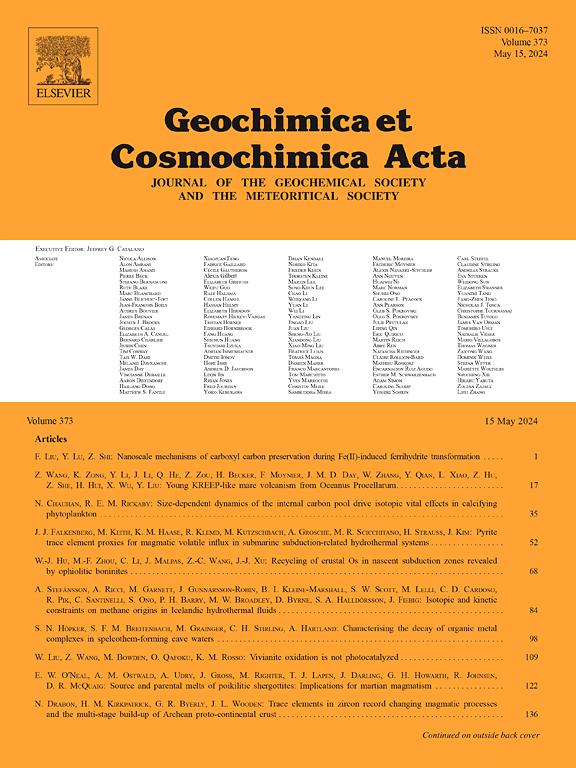浅水碳酸盐作为表层海水镍同位素组成记录的保真度评估
IF 5
1区 地球科学
Q1 GEOCHEMISTRY & GEOPHYSICS
引用次数: 0
摘要
镍是一种生物必需金属,被用于对碳、氮和氧循环至关重要的酶中,其海洋丰度和生物利用度的变化可能影响了早期生命的进化轨迹。地表海水的Ni同位素组成(δ60Ni)随时间的变化反映了生物对Ni的需求,可以重建地球历史上Ni需求的动态,但这种方法需要地表海水的地质记录。在这里,我们通过确定Ni如何首先划分为天然碳酸盐以及沉积后过程如何影响Ni信号来研究浅水碳酸盐作为地表海水Ni同位素组成记录的保真度。我们的样本来自大巴哈马滩,这是一个研究得很好的现代碳酸盐台地,经常被用来研究古代台地。我们发现,Ni在加入碳酸盐中后从海水中分馏出来,这些碳酸盐捕获浅层(<18 cm),最近沉积(比海水轻0.1 ‰至0.4 ‰)。这些[Ni]和δ60Ni值的变化可能受矿物比例变化的控制。大气成岩作用使δ60Ni向较低值移动,我们将其归因于同位素轻的大气流体。相比之下,在Ca同位素和Sr/Ca比值方面,经历沉积缓冲的海洋成岩作用的碳酸盐与通常代表其初始沉积的沉积物的δ60Ni值似乎没有差异。这些样品中δ60Ni对成岩重置的敏感性与Ca同位素和Sr/Ca比值的敏感性相当,均为一级。因此,总的来说,在这些元素方面,经历沉积缓冲海洋成岩作用的碳酸盐可能最有希望作为同时期表层海水δ60Ni的记录。此外,我们利用我们的结果推断,从海水中转移到碳酸盐中的Ni的比例小于全球海洋Ni输出总量的10% %,并且将这一Ni汇纳入全球生物地球化学模型只会对模拟的现代Ni收支产生轻微影响。本文章由计算机程序翻译,如有差异,请以英文原文为准。
Assessing the fidelity of shallow-water carbonates as records of the Ni isotope composition of surface seawater
Nickel is a bioessential metal that is used in enzymes important to the C, N, and O cycles, and changes in its marine abundance and bioavailability may have affected the evolutionary trajectory of early life. Changes over time in the Ni isotope composition (δ60Ni) of surface seawater, which reflects biological demand for Ni, could allow for the reconstruction of the dynamics of Ni demand over Earth’s history, but this approach would require geologic records of surface seawater. Here, we investigate the fidelity of shallow-water carbonates as a record of the Ni isotope composition of surface seawater by determining how Ni is first partitioned into natural carbonates and then how post-depositional processes influence the Ni signal. Our samples come from the Great Bahama Bank, which is a well-studied, modern carbonate platform often used to study ancient platforms. We found that Ni is fractionated from seawater upon incorporation into carbonates capturing shallow (<18 cm), recent deposition (0.1 ‰–0.4 ‰ lighter than seawater). Variation among these [Ni] and δ60Ni values may be controlled by variation in mineral proportions. Meteoric diagenesis shifts δ60Ni to lower values, which we attribute to isotopically light meteoric fluids. In contrast, carbonates that experienced sediment-buffered marine diagenesis with respect to Ca isotopes and Sr/Ca ratios do not appear to differ in δ60Ni values from sediments generally representative of their initial deposition. The sensitivity of δ60Ni to diagenetic reset in these samples appears comparable to the sensitivities of Ca isotopes and Sr/Ca ratios, to first order. Thus, in general, carbonates that experienced sediment-buffered marine diagenesis with respect to these elements may hold the most promise as a record of the δ60Ni of coeval surface seawater. Additionally, we use our results to infer that the fraction of Ni removed from seawater into carbonates is less than 10 % of the total Ni output from the global oceans and incorporation of this Ni sink into global biogeochemical models will only have a minor impact on the modeled modern Ni budget.
求助全文
通过发布文献求助,成功后即可免费获取论文全文。
去求助
来源期刊

Geochimica et Cosmochimica Acta
地学-地球化学与地球物理
CiteScore
9.60
自引率
14.00%
发文量
437
审稿时长
6 months
期刊介绍:
Geochimica et Cosmochimica Acta publishes research papers in a wide range of subjects in terrestrial geochemistry, meteoritics, and planetary geochemistry. The scope of the journal includes:
1). Physical chemistry of gases, aqueous solutions, glasses, and crystalline solids
2). Igneous and metamorphic petrology
3). Chemical processes in the atmosphere, hydrosphere, biosphere, and lithosphere of the Earth
4). Organic geochemistry
5). Isotope geochemistry
6). Meteoritics and meteorite impacts
7). Lunar science; and
8). Planetary geochemistry.
 求助内容:
求助内容: 应助结果提醒方式:
应助结果提醒方式:


